Potential for Net-Zero Energy Communities in Kuwait: An Empirical Techno-Economic Modeling and Optimization Approach
Abstract
:1. Introduction
1.1. Background
1.2. From Net-Zero Energy Buildings to Communities
1.3. Objectives and Expected Contributions
- Is the NZEC concept techno-economically viable in typical Kuwaiti communities/cities?
- What combinations of urban form (e.g., villas, multi-family, and office) present the most favorable conditions for an effective NZEC development?
- What are the main enablers for NZEC adoption and deployment?
2. Materials and Methods
2.1. Phase I—Data Gathering and Building Performance Simulation Models
2.2. Phase II—Hourly Energy Demand Profile Generation
2.3. Phase III—Urban Energy Demand and Community Configurations
2.4. Phase IV—Renewable Energy Generation and Storage Modeling
2.5. Phase V—Financial Modeling and Optimization
2.6. Phase VI—Experimental Design, Scenario, and Analysis
3. Results
3.1. “No Grid Exchange” Results: Scenario A
3.2. “Grid Connection and Net-Metering” Results: Scenario B
4. Discussion
- Research question #1: Is the NZEC concept techno-economically viable in typical Kuwaiti communities/cities?
- Recommendation #1: Prioritize strategies and advanced feasibility assessments to enable consumers to sell back excessive energy generated from renewable energy sources to the grid.
- Research question #2: What combinations of urban form (e.g., villas, multi-family, and office) present the most favorable conditions for an effective NZEC development?
- Recommendation #2: Prioritize NZEC developments with a strategic mix of different building types, avoiding communities predominantly composed of single-family villas.
- Research question #3: What are the main enablers for NZEC adoption and deployment?
- Recommendation #3: Prioritize large-scale energy-efficiency programs in parallel to subsidy re-allocation strategies to reduce the capital costs of renewable energy generation and storage systems by a minimum of 30%.
5. Conclusions
Author Contributions
Funding
Data Availability Statement
Conflicts of Interest
References
- Kuwait Institute for Scientific Research (KISR). Kuwait Energy Outlook 2019; Kuwait Institute for Scientific Research (KISR): Kuwait City, Kuwait, 2019. [Google Scholar]
- IEA. IEA Atlas of Energy. International Energy Agency (IEA), 2017. Available online: http://energyatlas.iea.org/#!/tellmap/-1118783123/1 (accessed on 15 July 2023).
- IEA. Data and Statistics. International Energy Agency (IEA), 2018. Available online: https://www.iea.org/data-and-statistics?country=KUWAIT&fuel=Energyconsumption&indicator=Electricityfinalconsumptionbysector (accessed on 15 July 2023).
- U. ESCWA. Analysis of Economic and Environmental Benefits of Promoting Energy Efficiency in Buildings. Case Study. United Nations Economic and Social Commission for West Asia (UN ESCWA), 2015. Available online: http://www.unece.org/fileadmin/DAM/energy/se/pdfs/gee21/projects/others/Kuwait.pdf (accessed on 15 July 2023).
- Al-Hadban, Y.; Sreekanth, K.J.; Al-Taqi, H.; Alasseri, R. Implementation of Energy Efficiency Strategies in Cooling Towers—A Techno-Economic Analysis. J. Energy Resour. Technol. 2017, 140, 012001. [Google Scholar] [CrossRef]
- Darwish, M.A. Building air conditioning system using fuel cell: Case study for Kuwait. Appl. Therm. Eng. 2007, 27, 2869–2876. [Google Scholar] [CrossRef]
- Sedaghat, A.; Alkhatib, F.; Oloomi, S.A.A.; Sabri, F.; Salem, H.; Sabati, M.; Zafar, W.J.; Malayer, M.A.; Negahi, A. Experimental study on the performance of solar window films in office buildings in Kuwait. J. Nanoparticle Res. 2020, 22, 85. [Google Scholar] [CrossRef]
- AlAnzi, A.; Seo, D.; Krarti, M. Impact of building shape on thermal performance of office buildings in Kuwait. Energy Convers. Manag. 2009, 50, 822–828. [Google Scholar] [CrossRef]
- Krarti, M. Evaluation of large scale building energy efficiency retrofit program in Kuwait. Renew. Sustain. Energy Rev. 2015, 50, 1069–1080. [Google Scholar] [CrossRef]
- Alasseri, R.; Tripathi, A.; Rao, T.J.; Sreekanth, K. A review on implementation strategies for demand side management (DSM) in Kuwait through incentive-based demand response programs. Renew. Sustain. Energy Rev. 2017, 77, 617–635. [Google Scholar] [CrossRef]
- Ameer, B.; Krarti, M. Impact of subsidization on high energy performance designs for Kuwaiti residential buildings. Energy Build. 2016, 116, 249–262. [Google Scholar] [CrossRef]
- U. Nations (UN). Kuwait Voluntary National Review 2019. United Nations (UN), 2019. Available online: https://www.undp.org/kuwait/publications/kuwait-voluntary-national-review-2019 (accessed on 15 July 2023).
- AlAjmi, A.; Abou-Ziyan, H.; Ghoneim, A. Achieving annual and monthly net-zero energy of existing building in hot climate. Appl. Energy 2016, 165, 511–521. [Google Scholar] [CrossRef]
- Shandiz, S.C.; Rismanchi, B.; Foliente, G. Energy master planning for net-zero emission communities: State of the art and research challenges. Renew. Sustain. Energy Rev. 2020, 137, 110600. [Google Scholar] [CrossRef]
- Krarti, M.; Ihm, P. Evaluation of net-zero energy residential buildings in the MENA region. Sustain. Cities Soc. 2016, 22, 116–125. [Google Scholar] [CrossRef]
- Chicco, G.; Mancarella, P. Distributed multi-generation: A comprehensive view. Renew. Sustain. Energy Rev. 2009, 13, 535–551. [Google Scholar] [CrossRef]
- Fleischhacker, A.; Lettner, G.; Schwabeneder, D.; Auer, H. Portfolio optimization of energy communities to meet reductions in costs and emissions. Energy 2019, 173, 1092–1105. [Google Scholar] [CrossRef]
- He, D.; Xiong, Q.; Shi, X. Modeling of the renewable energy system of an net zero energy community. In Proceedings of the 29th Chinese Control and Decision Conference (CCDC), Chongqing, China, 28–30 May 2017; pp. 3590–3595. [Google Scholar] [CrossRef]
- Jank, R. Annex 51: Case studies and guidelines for energy efficient communities. Energy Build. 2017, 154, 529–537. [Google Scholar] [CrossRef]
- Sharifi, A.; Yamagata, Y. Principles and criteria for assessing urban energy resilience: A literature review. Renew. Sustain. Energy Rev. 2016, 60, 1654–1677. [Google Scholar] [CrossRef]
- Huang, P.; Wu, H.; Huang, G.; Sun, Y. A top-down control method of nZEBs for performance optimization at nZEB-cluster-level. Energy 2018, 159, 891–904. [Google Scholar] [CrossRef]
- Roberts, M.B.; Bruce, A.; MacGill, I. Impact of shared battery energy storage systems on photovoltaic self-consumption and electricity bills in apartment buildings. Appl. Energy 2019, 245, 78–95. [Google Scholar] [CrossRef]
- Azar, E.; Alaifan, B.; Lin, M.; Trepci, E.; El Asmar, M. Drivers of energy consumption in Kuwaiti buildings: Insights from a hybrid statistical and building performance simulation approach. Energy Policy 2021, 150, 112154. [Google Scholar] [CrossRef]
- Crawley, D.B.; Hand, J.W.; Kummert, M.; Griffith, B.T. Contrasting the capabilities of building energy performance simulation programs. Build. Environ. 2008, 43, 661–673. [Google Scholar] [CrossRef]
- U.S. Department of Energy’s (DOE). EnergyPlus Software. 2019. Available online: https://energyplus.net/ (accessed on 29 October 2022).
- Deru, M.; Field, K.; Studer, D.; Benne, K.; Griffith, B.; Torcellini, P.; Liu, B.; Halverson, M.; Winiarski, D.; Rosenberg, M.; et al. U.S. Department of Energy Commercial Reference Building Models of the National Building Stock. National Renewable Energy Laboratory (NREL). 2011. Available online: http://www.nrel.gov/docs/fy11osti/46861.pdf (accessed on 29 October 2022).
- Kuwait Ministry of Electricity and Water (MEW). Energy Conservation Program: Code of Practice—Report MEW/R-6/2014; Kuwait Ministry of Electricity and Water (MEW): Kuwait City, Kuwait, 2014.
- Kuwait Ministry of Electricity and Water (MEW). Energy Conservation Program: Code of Practice—Report MEW/R-6/2010; Kuwait Ministry of Electricity and Water (MEW): Kuwait City, Kuwait, 2010.
- ICC. IECC—International Energy Conservation Code; International Code Council (ICC): Washington, DC, USA, 2015. [Google Scholar]
- ASHRAE. ANSI/ASHRAE Standard 62.1-2010, Ventilation for Acceptable Indoor Air Quality; American Society of Heating, Refrigerating and Air-Conditioning Engineers (ASHRAE): Atlanta, GA, USA, 2007. [Google Scholar]
- DOE. Commercial Prototype Building Models. United States Department of Energy (DOE), 2018. Available online: https://www.energycodes.gov/development/commercial/prototype_models (accessed on 15 July 2023).
- Sokol, J.; Davila, C.C.; Reinhart, C.F. Validation of a Bayesian-based method for defining residential archetypes in urban building energy models. Energy Build. 2017, 134, 11–24. [Google Scholar] [CrossRef]
- Al-Mumin, A.; Khattab, O.; Sridhar, G. Occupants’ behavior and activity patterns influencing the energy consumption in the Kuwaiti residences. Energy Build. 2003, 35, 549–559. [Google Scholar] [CrossRef]
- National Renewable Energy Laboratory (NREL). Definition of a “Zero Net Energy Community”. NREL, Boulder, CO; 2009. Available online: https://www.nrel.gov/docs/fy10osti/46065.pdf (accessed on 18 September 2022).
- HOMER Energy Pro. Available online: www.homerenergy.com (accessed on 15 July 2023).
- HOMER Energy. HOMER Calculations. 2023. Available online: https://www.homerenergy.com/products/pro/docs/3.11/homers_calculations.html (accessed on 6 July 2023).
- United States Energy Information Administration (US EIA). Cost and Performance Characteristics of New Generating Technologies; United States Energy Information Administration (US EIA): Washington, DC, USA, 2022. Available online: https://www.eia.gov/outlooks/aeo/assumptions/pdf/table_8.2.pdf (accessed on 6 July 2023).
- Krarti, M.; Aldubyan, M. Role of energy efficiency and distributed renewable energy in designing carbon neutral residential buildings and communities: Case study of Saudi Arabia. Energy Build. 2021, 250, 111309. [Google Scholar] [CrossRef]
- The World Bank. Inflation and Consumer Prices. World Bank Open Data. 2023. Available online: https://data.worldbank.org/indicator/FP.CPI.TOTL.ZG?locations=KW (accessed on 6 July 2023).
- Kuwait Ministry of Electricty & Water & Renewable Energy. Website. 2023. Available online: https://www.mew.gov.kw (accessed on 6 July 2023).
- Al Mansour, M.; Krarti, M. Value engineering optimal design approach of high-performance residential buildings: Case study of Kuwait. Energy Build. 2022, 258, 111833. [Google Scholar] [CrossRef]
- Alnaser, N.W.; Albuflasa, H.M.; Alnaser, W.E. The Transition in Solar and Wind Energy Use in Gulf Cooperation Council Countries (GCCC). Renew. Energy Environ. Sustain. 2022, 7, 4. [Google Scholar] [CrossRef]
- Chen, Y.; Chen, Z.; Yuan, X.; Su, L.; Li, K. Optimal Control Strategies for Demand Response in Buildings under Penetration of Renewable Energy. Buildings 2022, 12, 371. [Google Scholar] [CrossRef]
- Poudineh, R.; Sen, A.; Fattouh, B. Advancing renewable energy in resource-rich economies of the MENA. Renew. Energy 2018, 123, 135–149. [Google Scholar] [CrossRef]
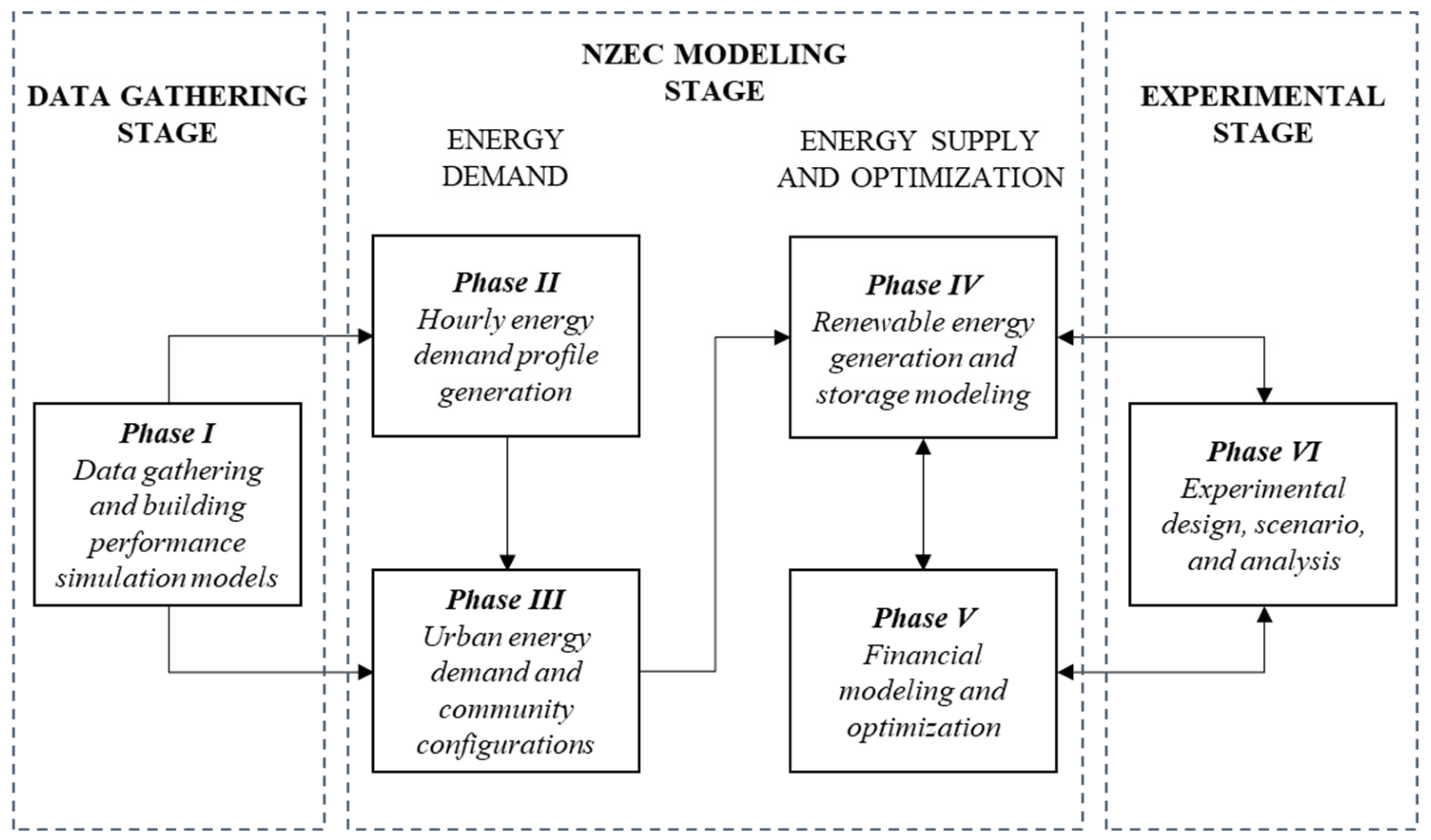


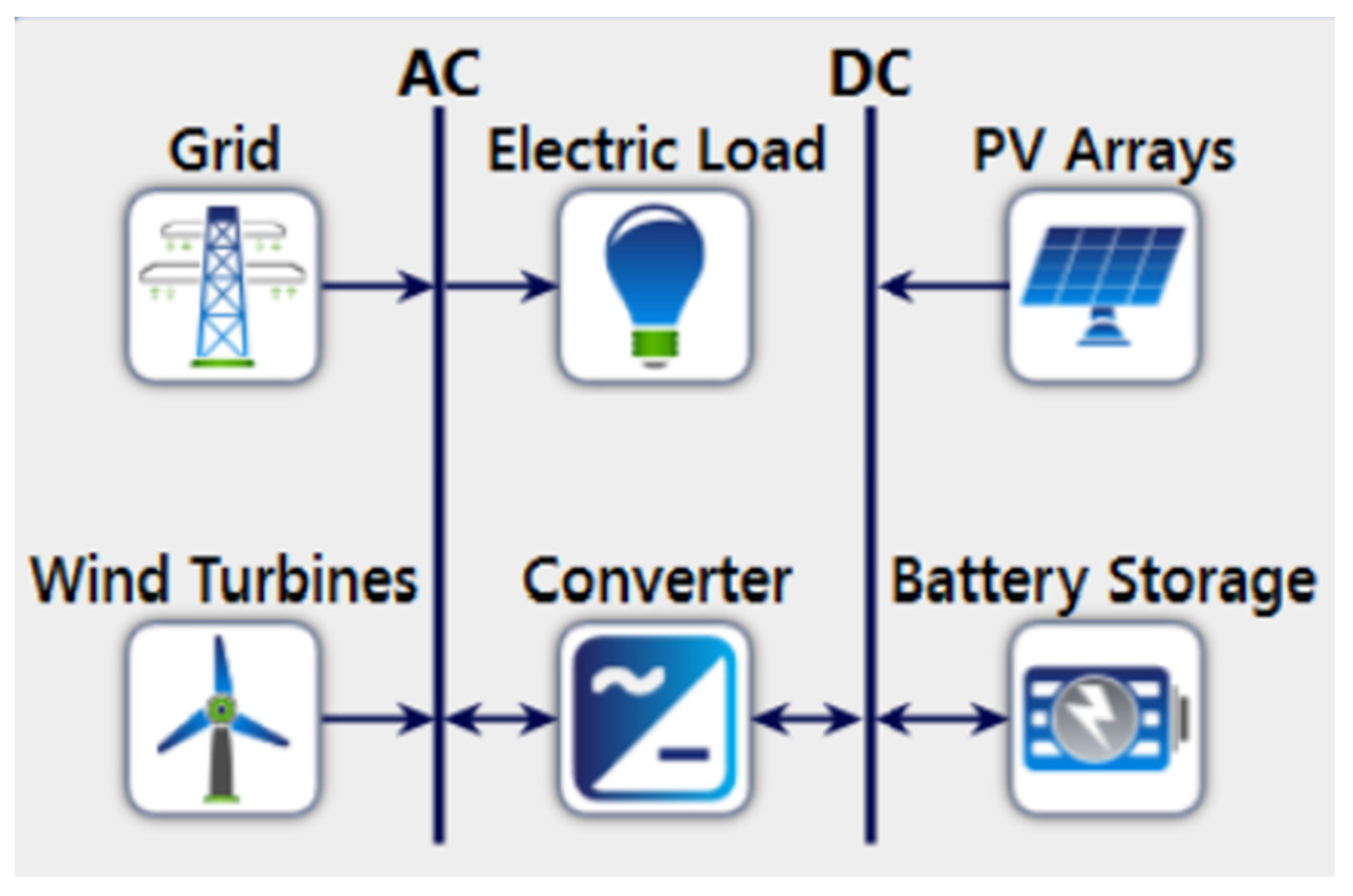
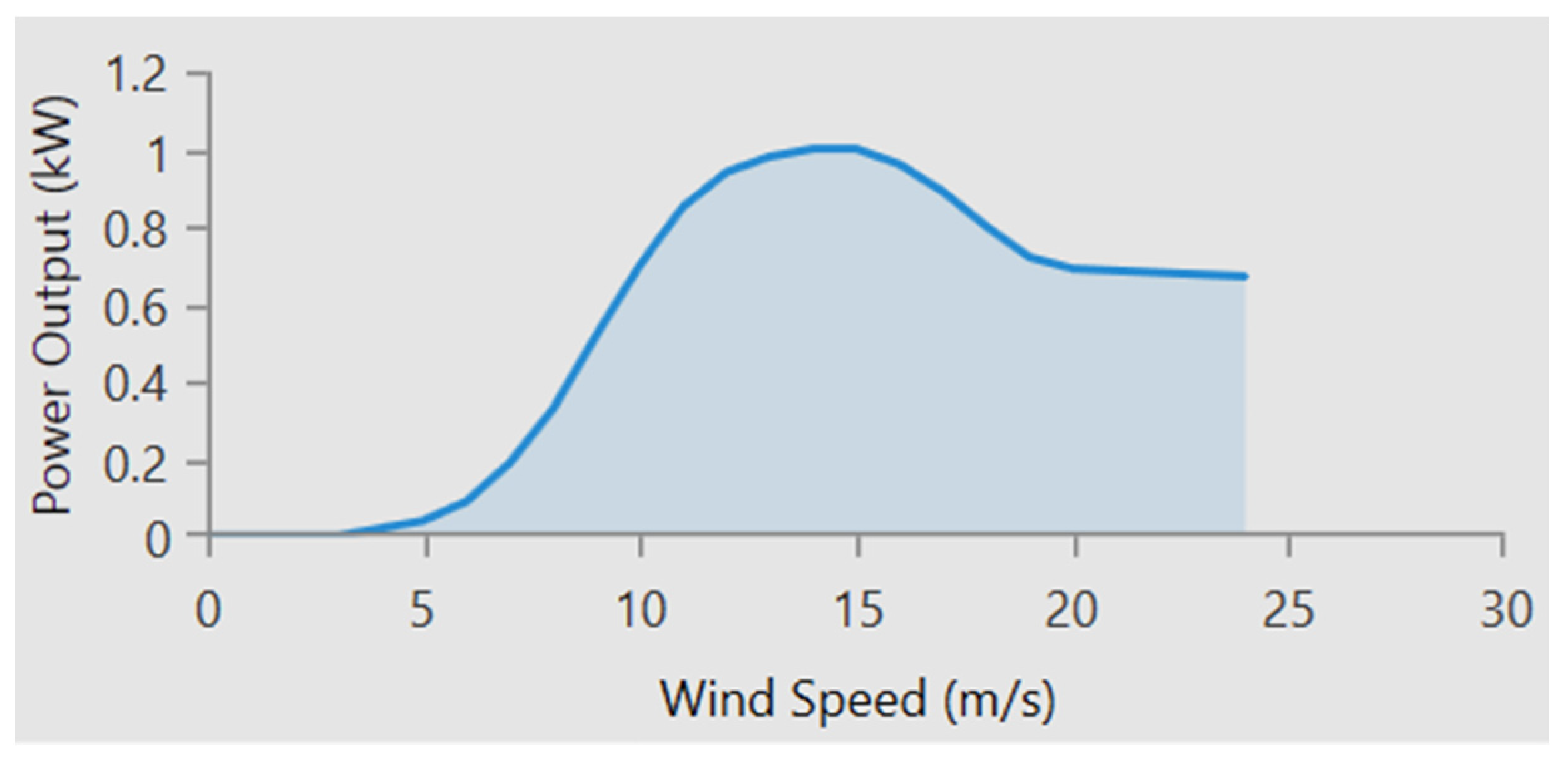

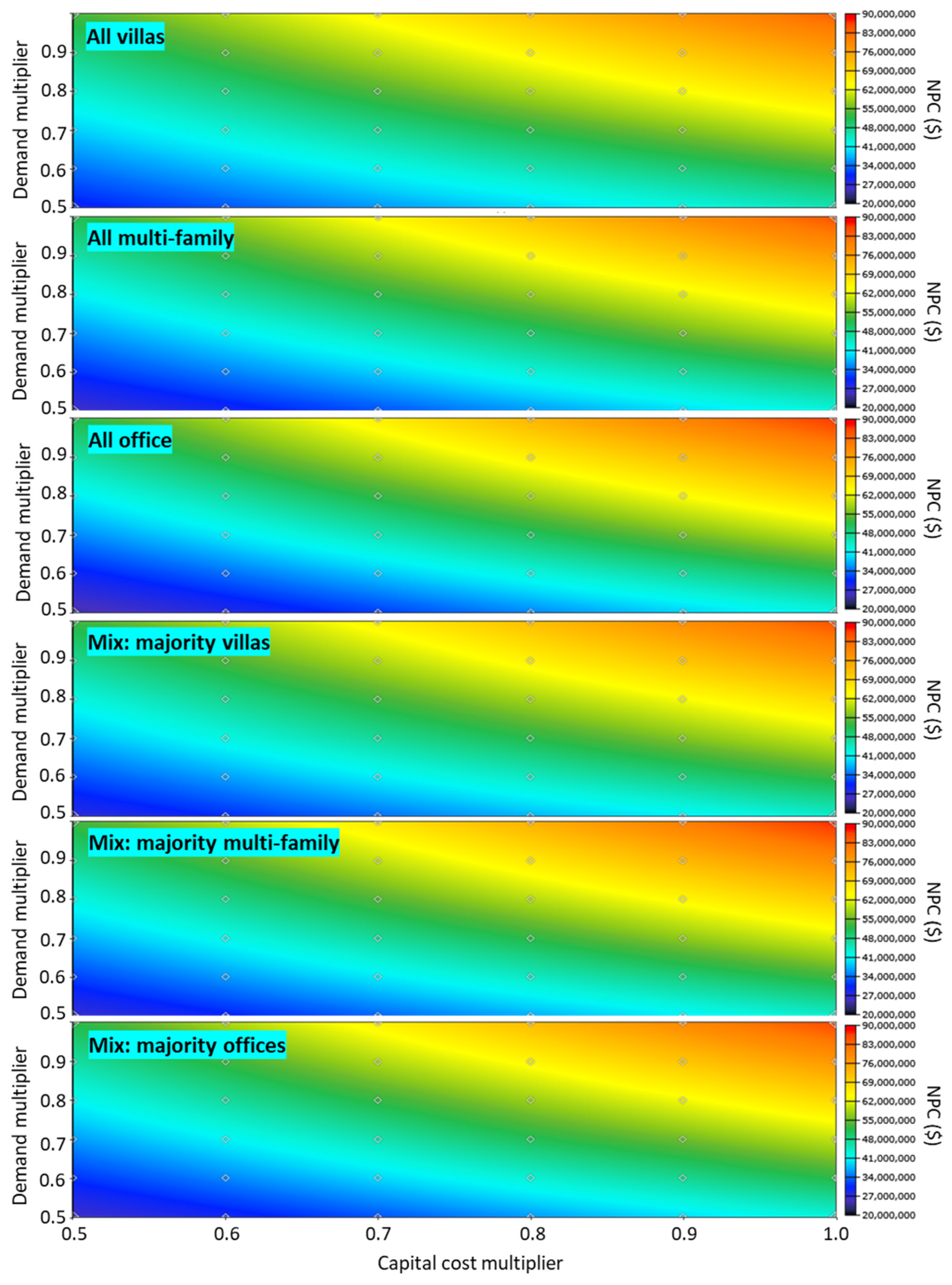
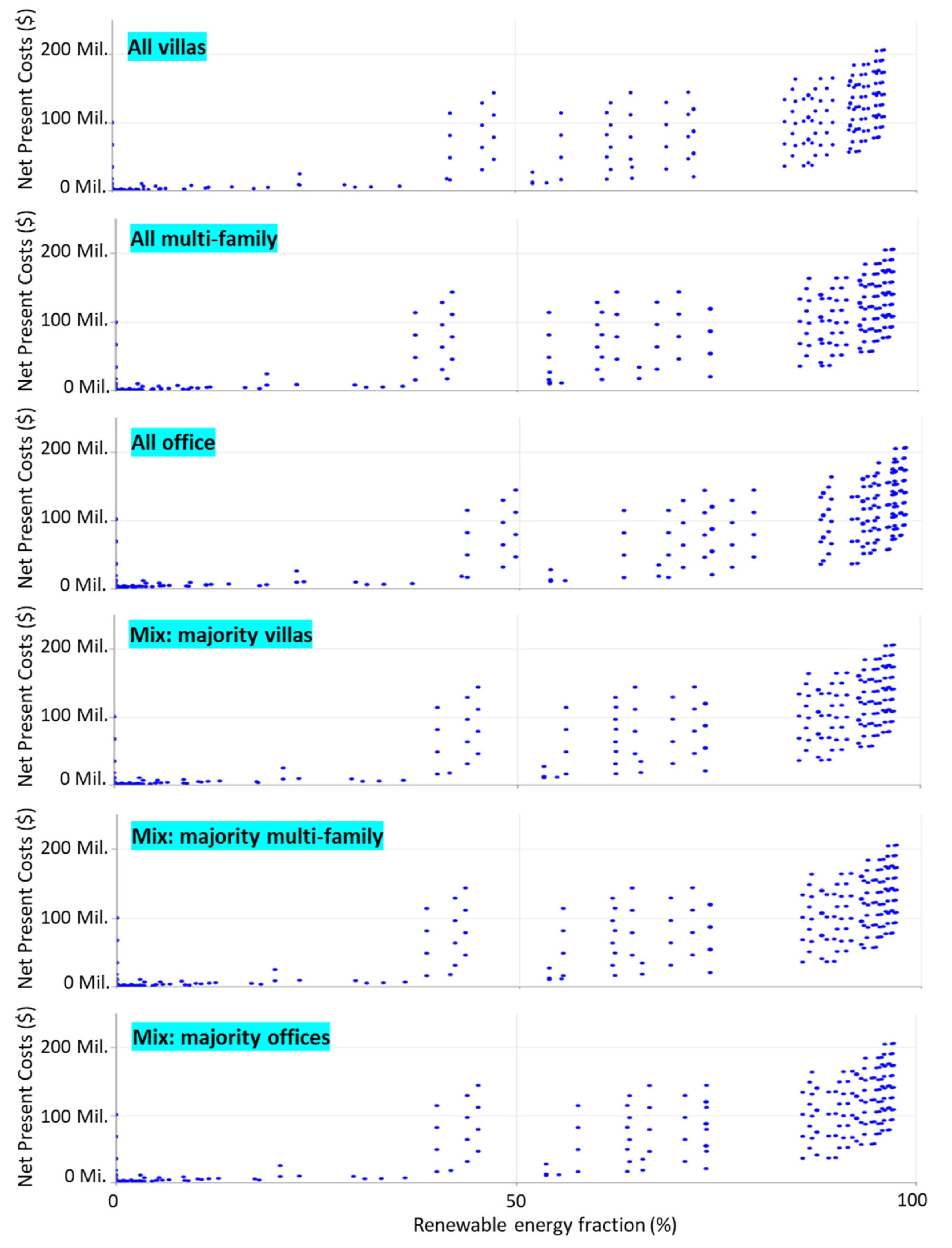
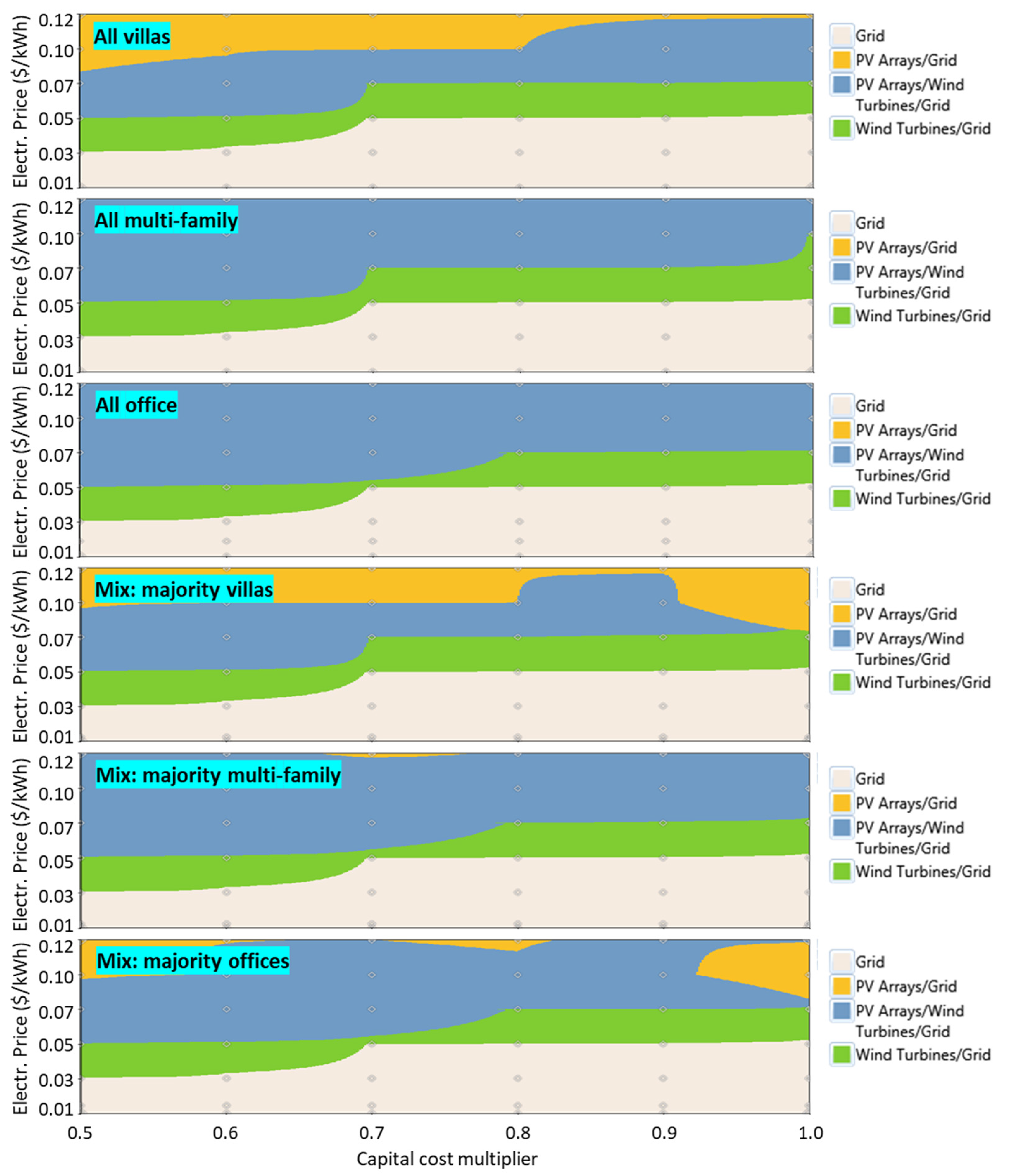
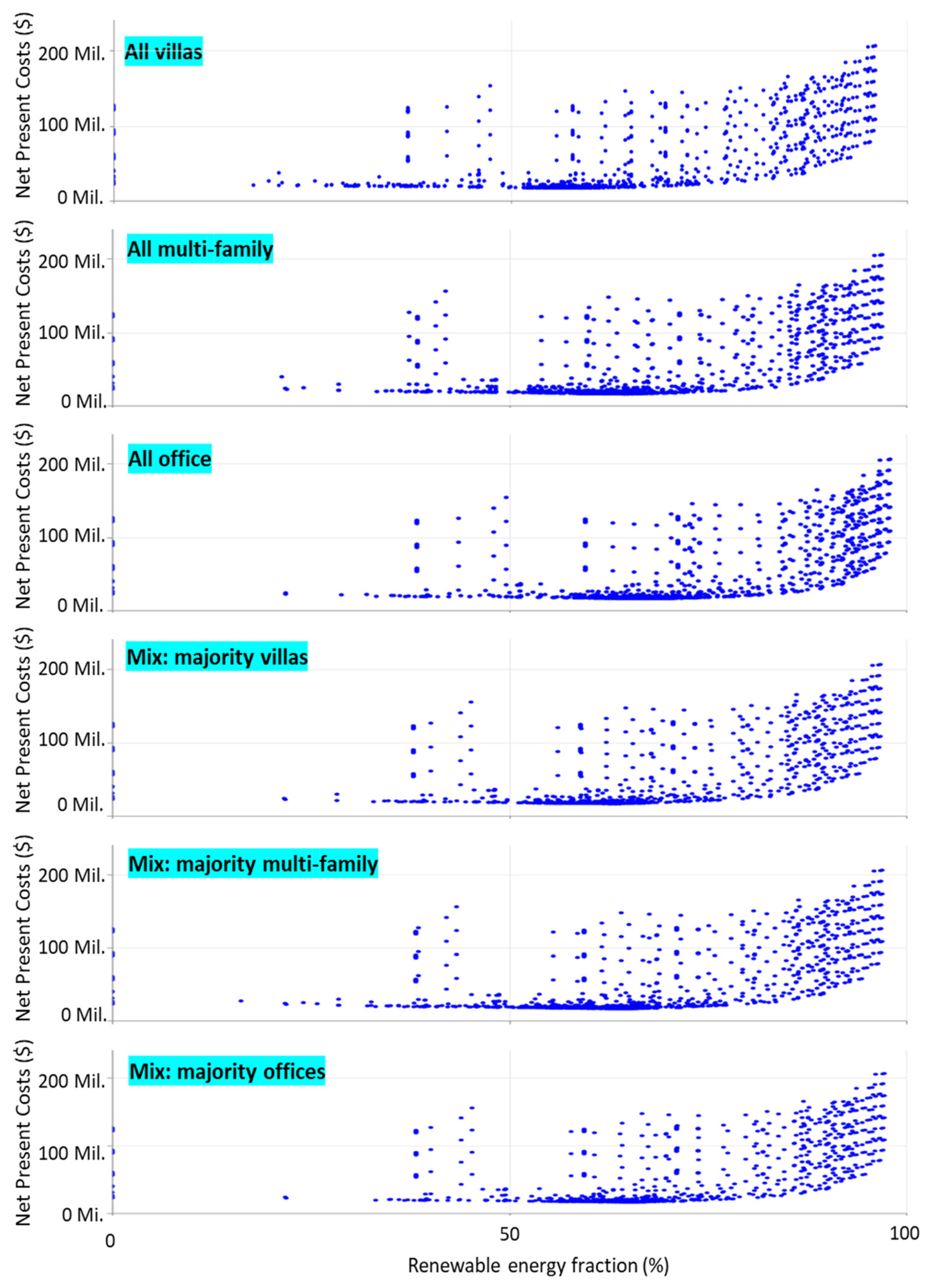
| Parameter | Range of Values |
|---|---|
| Building type | Commercial, residential (single-family), residential (multi-family) |
| Location | District name (total of 26) |
| Plot area | Numerical (m2) |
| Built-up area | Numerical (m2) |
| Number of floors | Numerical |
| Construction year | Numerical |
| Air conditioning system type | Chiller, Package, Split, Split and package |
| Building schedule | Descriptive |
| Electrical use intensity | Numerical (kWh/m2/year) |
| Configurations | Share of Energy Demand (# of Buildings) | ||
|---|---|---|---|
| Villas | Multi-Family | Offices | |
| All villas | 100% (186) | 0% (0) | 0% (0) |
| All multi-family | 0% (0) | 100% (13) | 0% (0) |
| All office | 0% (0) | 0% (0) | 100% (4) |
| Mix: majority villa | 50% (93) | 25% (3) | 25% (1) |
| Mix: majority multi-family | 25% (47) | 50% (6) | 25% (1) |
| Mix: majority offices | 25% (47) | 25% (3) | 50% (2) |
| Parameters | Generic Solar PV Panel | Generic Wind Turbine | Generic Li-Ion Battery |
|---|---|---|---|
| Capital Costs ($/kW) | 1327.00 | 1718.00 | 1316.00 |
| Operation and Maintenance ($/kW) | 15.97 | 27.57 | 25.96 |
| Lifetime (years) | 25 | 25 | 12.5 |
| Metric | All Villas | All Muti-Family | All Office | Mix: Majority Villas | Mix: Majority Multi-Family | Mix: Majority Offices |
|---|---|---|---|---|---|---|
| PV capacity (kW) | 15,326 | 14,480 | 16,856 | 19,378 | 13,326 | 14,738 |
| Wind capacity (kW) | 4427 | 4577 | 3556 | 10,794 | 4177 | 3388 |
| Battery capacity (kW) | 27,010 | 18,033 | 14,725 | 23,269 | 20,034 | 22,220 |
| NPC (Mil. $) | 113.6 | 86.6 | 79.0 | 123.6 | 89.6 | 96.3 |
| LCOE ($/kWh) | 0.600 | 0.458 | 0.416 | 0.659 | 0.474 | 0.510 |
| Benchmark NPC (grid-only) (Mil. $) | 1.3 | 1.3 | 3.2 | 1.8 | 1.8 | 2.2 |
| Benchmark LCOE (grid-only) ($/kWh) | 0.0065 | 0.0065 | 0.0164 | 0.0090 | 0.0090 | 0.0115 |
Disclaimer/Publisher’s Note: The statements, opinions and data contained in all publications are solely those of the individual author(s) and contributor(s) and not of MDPI and/or the editor(s). MDPI and/or the editor(s) disclaim responsibility for any injury to people or property resulting from any ideas, methods, instructions or products referred to in the content. |
© 2023 by the authors. Licensee MDPI, Basel, Switzerland. This article is an open access article distributed under the terms and conditions of the Creative Commons Attribution (CC BY) license (https://creativecommons.org/licenses/by/4.0/).
Share and Cite
Alaifan, B.; Azar, E. Potential for Net-Zero Energy Communities in Kuwait: An Empirical Techno-Economic Modeling and Optimization Approach. Buildings 2023, 13, 2096. https://doi.org/10.3390/buildings13082096
Alaifan B, Azar E. Potential for Net-Zero Energy Communities in Kuwait: An Empirical Techno-Economic Modeling and Optimization Approach. Buildings. 2023; 13(8):2096. https://doi.org/10.3390/buildings13082096
Chicago/Turabian StyleAlaifan, Bader, and Elie Azar. 2023. "Potential for Net-Zero Energy Communities in Kuwait: An Empirical Techno-Economic Modeling and Optimization Approach" Buildings 13, no. 8: 2096. https://doi.org/10.3390/buildings13082096






